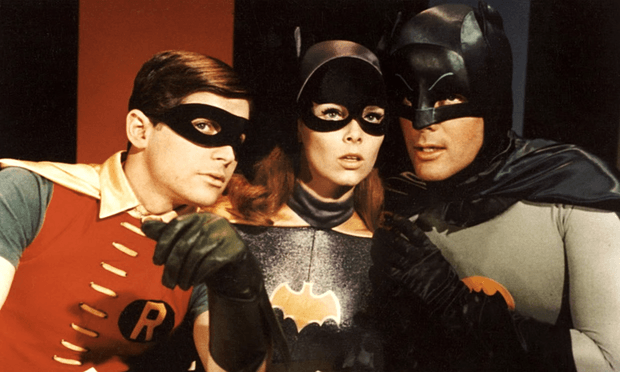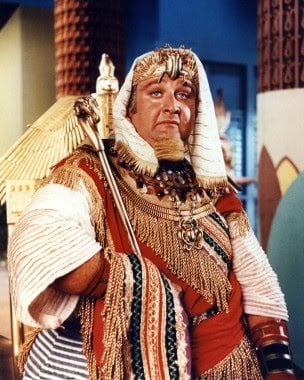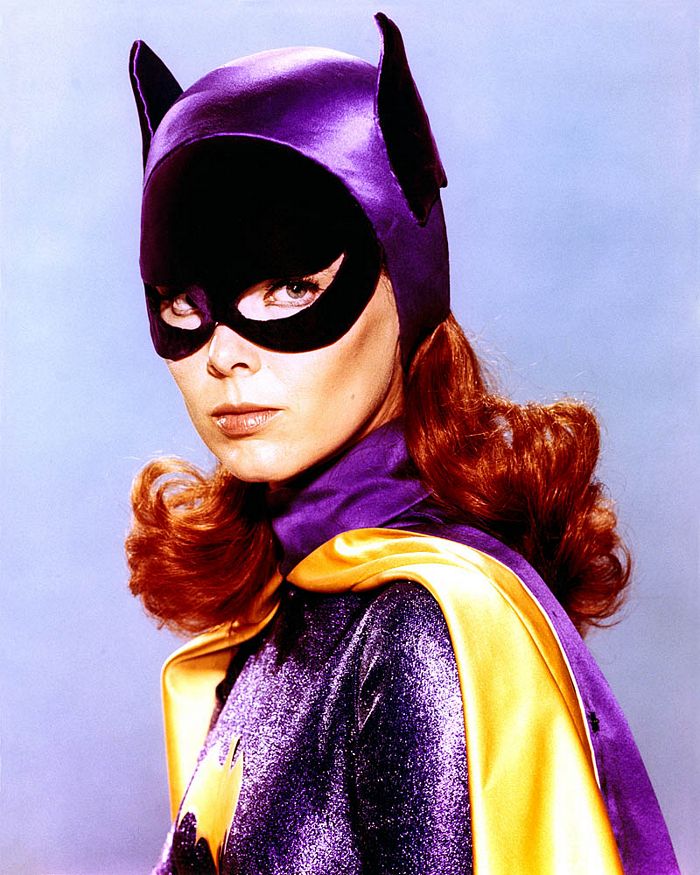
Exactly 50 years ago, ‘Batman’ Biff-ed, Bam-ed and Pow-ed his way into living rooms across the country and took the world by storm! Though for many years the series, which lasted three seasons from 1966-68, elicited revulsion from more serious-minded comic book fans, in recent years, the ice has thawed and fans have embraced the colorful, comedic program. The entire series is now finally available on DVD. (It was NEVER available on VHS or any other form of home video.) Mattel has released numerous toys based on this version, and the ‘Batman ’66‘ comic (digital to print), based on the show, has proven a strong seller and been critically acclaimed.
The original show starred virtual unknowns Adam West as Batman/Bruce Wayne and Burt Ward as Robin/Dick Grayson, as well as Alan Napier as Alfred, Madge Blake as Aunt Harriet, Neil Hamilton as Commissioner Gordon and Stafford Repp as Police Chief O’Hara. The Batman comic books of this period had long since deviated from the nocturnal noir of early issues and the show reflected that, as most of the action took place in the clean, impeccably manicured, daytime Gotham City, which was essentially an Everytown U.S.A. not the slimy cesspool we’re used to seeing nowadays.
The show was an immediate sensation, airing twice a week on Wednesday and Thursday nights, with both ranking in the top ten of 1966. The show even spawned a theatrical movie starring the TV cast (with Lee Meriweather stepping in as Catwoman, because TV actress Julie Newmar had a prior film commitment). A merchandising blitz the likes of which had never been seen bathed the country in everything from the usual Batman toys, puzzles, games and books to ice cream and bread! A nightclub in Hollywood was even renamed Wayne Manor and partygoers were beguiled by female go-go dancers dressed as Robin!

The Batmania was short-lived and the show was cut to only one airing a week for its final season. And while ratings plummeted, fans fondly remember these episodes because they featured Yvonne Craig as Batgirl/Barbara Gordon, one of the ass-kicking-est female heroes in TV history. Due to more scheduling conflicts, Julie Newmar was permanently replaced as Catwoman with African American singer/actor Eartha Kitt, whose purrrrrrrfect feline growl made her many viewers’ favorite take on the “Villainess” despite the fact that the previously established sexual tension between Catwoman and Batman was eliminated with her arrival.
Even though some fans who prefer their Batman grittier, the show made an indelible mark on the comic book Caped Crusader. Even after the publication of Frank Miller’s back-to-bleak-basics ‘The Dark Knight Return’, when polled as to which villains audiences wanted to see in the first round of ‘Batman’ movies, two of the most popular selections were King Tut and Egghead, foes created for the TV show. (King Tut has even been adapted to the comics, as has supporting character Police Chief O’Hara.)

Perhaps the biggest comic addition from the show was Batgirl/Barbara Gordon. When producers wanted to add the redhead ace to the show for the third season, DC supported the move by first premiering the character, Commissioner Gordon’s librarian daughter, in the comics. Batgirl has gone on to become one of the most visible licensed female comic book characters, alongside Wonder Woman, Supergirl and Catwoman. After serving as Oracle for many years, Barbara is back in the Batgirl role that made her famous, starring in her own comic series for the first time ever.
But the biggest impact that the TV show had on the character of Batman was simply making him… The Man. Since his creation in 1939, Batman had always played second fiddle to Superman. It was the TV show that made Batman/Bruce Wayne a household name and did the same for his supporting cast and villains. The public had gone wild for the god-like Superman when he was introduced, but not even Kal-El had created a sweeping craze like ‘Batman’ had.
When Mego began manufacturing toys based on the DC Comics roster of heroes and villains, it was Batman’s crew that factored the most heavily. Not only were Batman, Robin and Batgirl part of the heroic lineup, in various scales, but of the five super villains in the line, four were Batman’s– Catwoman, The Joker, The Penguin and The Riddler. (The fifth was, oddly, Superman’s magical foil Mxyzptlyk.) In addition, Mego padded out the line with Batcave and Wayne Foundation playsets and Batmobile, Batcycle and Batcopter vehicles, all of which were designed based on their depiction on the TV show.
Prior to the show’s release, DC was on the verge of cancelling the Batman comics altogether. After the show, Batman quickly rose to become DC’s most featured star, a status that continues to this day.
The technicolor costumes and sets, the visual sound effects and adult-skewing humor may have rankled more serious comic book readers for decades but without the campy 60s TV show and it’s immersing the world’s culture in all things Batty, there may never have been a ‘Dark Knight Returns’ or the 1989 Tim Burton-directed film… or any of the movies that followed, including the Academy Award winning ‘The Dark Knight’.
Luckily, most fans have now come to embrace the fact that like all forms of entertainment, comics and their adaptations are a product of their times. ‘Batman’ was perfect for the pop art-drenched late 60s and without it, it’s quite possible that the character may have gone the way of the Lone Ranger and Buck Rogers, heroes of yesteryear that were no longer viable or relevant.
So Happy 50th Anniversary ‘Batman’ TV show!
Have any fond memories of watching ‘Batman’? Or do you still dismiss this show as campy, harmful fluff? Comment below!
